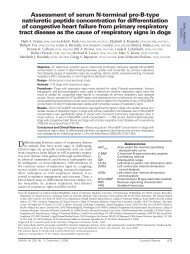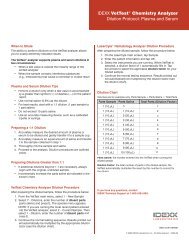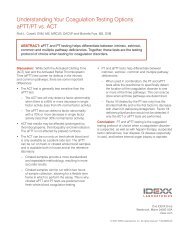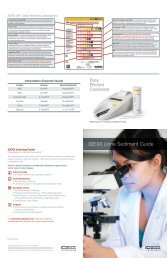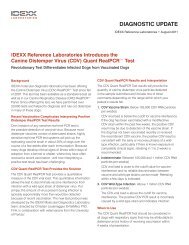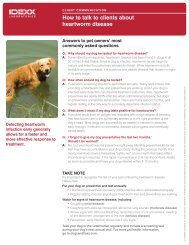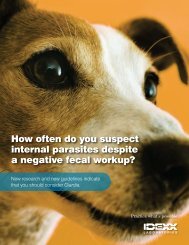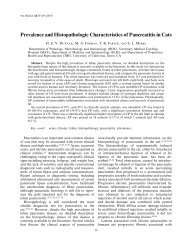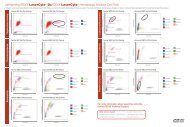Canine parvovirus - IDEXX Laboratories
Canine parvovirus - IDEXX Laboratories
Canine parvovirus - IDEXX Laboratories
You also want an ePaper? Increase the reach of your titles
YUMPU automatically turns print PDFs into web optimized ePapers that Google loves.
Ask us about how we can<br />
protect your dog from<br />
canine <strong>parvovirus</strong><br />
Parvovirus can be spread when a dog comes in<br />
contact with the feces of an infected dog. The<br />
virus can remain infectious on contaminated<br />
ground for five months or more. As a result, your<br />
pet can contract <strong>parvovirus</strong> anywhere dogs come<br />
together—such as parks, kennels, shelters and<br />
pet stores.<br />
<strong>Canine</strong> <strong>parvovirus</strong><br />
What you need to know<br />
to protect your pet from<br />
this common virus<br />
What harm is done by<br />
canine <strong>parvovirus</strong><br />
Once the virus enters your pet’s body, it multiplies<br />
in the bone marrow, intestinal tract and immune<br />
system. As the virus matures and reproduces<br />
(over about five days), it can cause life-threatening<br />
damage to your pet’s immune system and<br />
intestinal tract. Without fast diagnosis and<br />
treatment, your pet may die from dehydration<br />
and/or bacterial infection.<br />
It is very important that you protect your pet from<br />
the threat of <strong>parvovirus</strong>. Talk to your veterinarian<br />
about the prevention, diagnosis and treatment of<br />
this deadly disease.<br />
Parvovirus symptoms<br />
If you see any of the following symptoms in your puppy<br />
or dog, contact your veterinarian immediately:<br />
• Lack of appetite<br />
• Lethargy or listlessness<br />
• Vomiting<br />
• Fever<br />
• Abdominal distention<br />
(pot belly) or discomfort<br />
• Signs of dehydration<br />
• Bloody diarrhea<br />
• Profuse diarrhea<br />
The combination of symptoms can vary, therefore,<br />
<strong>parvovirus</strong> is difficult to diagnose based on symptoms<br />
alone. Rapid, in-clinic tests are crucial for diagnosis<br />
and appropriate therapy.<br />
Vaccination is a very effective step to prevent this<br />
threatening disease. Please talk with us about<br />
vaccinating your dog.<br />
© 2008 <strong>IDEXX</strong> <strong>Laboratories</strong>, Inc. All rights reserved. • 09-60067-07<br />
SNAP and Practice what’s possible are trademarks or registered trademarks<br />
of <strong>IDEXX</strong> <strong>Laboratories</strong>, Inc. in the United States and/or other countries.
What is<br />
canine <strong>parvovirus</strong><br />
Understanding<br />
canine <strong>parvovirus</strong><br />
<strong>Canine</strong> <strong>parvovirus</strong> is one of the most common<br />
and severe gastrointestinal diseases of dogs.<br />
Parvovirus most frequently attacks puppies<br />
younger than one year of age. The virus is<br />
extremely contagious and strikes rapidly and<br />
without warning. While most infected adult dogs<br />
recover, as many as 25% to 50% of infected<br />
puppies die from the disease if not diagnosed<br />
and treated immediately.<br />
Diagnosis<br />
Your veterinarian can use a Snap ® Parvo Antigen<br />
Test to detect <strong>parvovirus</strong>. Early diagnosis is critical to<br />
providing immediate and life-saving treatment.<br />
Treatment<br />
Treatment is primarily aimed at correcting dehydration<br />
and preventing fatal infection. For a mildly affected<br />
pet (usually an adult dog), outpatient care can be<br />
all that is needed. Severely affected pets (typically<br />
puppies) generally require hospitalization and<br />
additional therapy, including:<br />
• Intravenous fluid therapy<br />
• Correction of electrolyte levels<br />
(sodium and potassium)<br />
• Intravenous glucose (blood sugar)<br />
• Broad-spectrum antibiotics<br />
• Anti-nausea medication<br />
• Attentive nursing care<br />
Your veterinarian may use other tests to monitor your<br />
pet’s condition. Successful recovery usually takes<br />
about three to seven days of intensive veterinary care.<br />
Prevention<br />
Your puppy can be vaccinated against <strong>parvovirus</strong>.<br />
Vaccination begins at six to eight weeks of age,<br />
with booster shots every three to four weeks until<br />
your puppy is 16 to 18 weeks old. After that, annual<br />
boosters maintain immunity.<br />
It is best to avoid taking your puppy to areas with<br />
lots of “dog traffic” until he or she completes the<br />
vaccination period and has full immunity.<br />
Talk to your veterinarian<br />
Your veterinarian is your best source of information<br />
about prevention, diagnosis and treatment.<br />
And remember, if you think your pet may have<br />
<strong>parvovirus</strong>, seek veterinary attention immediately.<br />
Early detection and treatment offer your pet the best<br />
chance against this deadly disease.



